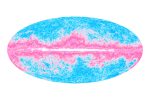
© 2021 Jonathan Feldschuh
These are strange paintings. They spell mayhem and decay.
Looking like cell and tissue lab specimens suspended in formaldehyde, one is taken aback by the intensity found in these abstract forms. Their loose cartoon-like shapes are drawn with anatomical precision although they are the by-products of a random process.
Using an expressionist painter’s drip and pour technique, the artist Jonathan Feldschuh layers his canvases with a thick build-up of several clear polymer coats which magnify colorful loopy forms floating beneath the transparent viscous surface. Quite heavy and industrial in appearance, these canvases, (stretched over wood panels), show details of organic forms which have been enlarged or reduced thousands of times in scale. With contrary titles like “Little Corner of the World” and “Wash It Till You Get It Clean”, this series has a humorous undercurrent.
In nature there are no straight lines -if we examine under a microscope the seemingly perfect straightness of a line, you’d note the rows of irregular edges that hold it all together. New connections between the whole and its summary parts would be revealed. In much the same way Feldschuh’s amorphous shapes float in space, spreading and congealing, imploding and exploding, tangling up into an array of non- specific mutations. Feldschuh shows us the fractal nature of ocular reality.
The boundaries between the unseen world and the seen are perhaps best explored through abstraction. Life is given to previously inanimate organisms; pigments bead and clump onto canvas, molecular activity at work.
Recent advances in molecular genetics have brought the biological sciences into the mainstream consciousness. The phenomenological questions speculating on why things look the way they do have been in the domain not only of scientists, but artists too.
The latest trends in abstraction have been beholden to a new 21st century Pop sensibility and a culture spawned and hybridized from nostalgia, technology, electronic music, and the Internet. Distinguished by their bright Pop colors, biomorphic forms and references to animation, two of Feldschuh’s abstract contemporaries, Giles Lyon and Mark Dean Veca feed off the bombardment of new media images. Veering off conceptually, Jonathan Feldschuh is more old school, less concerned (though attuned) with Pop culture, than with Post War history and the tenets of abstract expression. He brings a scientific background (via his study of physics at Harvard) into his approach to painting. The gestures that give a face to his abstractions are not easy to digest. They’re visceral and cryptic, even ungainly, as if the sexless forms were fighting their way up the evolutionary ladder only to be thwarted by inescapable forces. Experimenting with the cause and effect of deduction and logic, there remains a constant tension between an ever-present entropy and the containment of that morphing decay.
The last five years of the 20th century saw contemporary painting of every conceivable genre return to a prominent place in the Zeitgeist, as if it had gone anywhere in the first place. Digital art, and new media in general, is changing the practice of art making and how we perceive objects. The complexity of the natural world is now aped in genetic cloning and virtual verisimilitude. Ironically this series of paintings perform those very tasks-fantastical sci-fi creations that are creepy, uncanny, and elemental.

© 2021 Jonathan Feldschuh